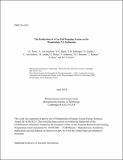The Realization of a Gas Puff Imaging System on the Wendelstein 7-X Stellarator
Author(s)
Terry, James L.; von Stechow, A.; Baek, Seung Gyou; Ballinger, S.B.; Grulke, O.; von Sehren, C.; Laube, R.; Killer, C.; Scharmer, F.; Brunner, K.J.; Knauer, J.; Bois, S.; W7-X Team; ... Show more Show less
Download24ja005_full.pdf (23.50Mb)
Metadata
Show full item recordAbstract
A system for studying the spatio-temporal dynamics of fluctuations in the boundary of the W7-X plasma using the ``Gas-Puff Imaging'' (GPI) technique has been designed, constructed, installed, and operated. This GPI system addresses a number of challenges specific to long-pulse superconducting devices like W7-X, including the long distance between the plasma and the vacuum vessel wall, the long distance between the plasma and diagnostic ports, the range of last closed flux surface (LCFS) locations for different magnetic configurations in W7-X, and management of heat loads on the system's plasma-facing components. The system features a pair of ``converging-diverging'' nozzles for partially collimating the gas puffed locally approximately 110 mm radially outboard of the plasma boundary, a pop-up turning mirror for viewing the gas puff emission from the side (which also acts as a shutter for the re-entrant vacuum window), and a high-throughput optical system that collects visible emission resulting from the interaction between the puffed gas and the plasma and directs it along a water-cooled re-entrant tube directly onto the 8 x 16 pixel detector array of the fast camera. The DEGAS 2 neutrals code was used to simulate the H-alpha (656 nm) and the HeI (587 nm) line emission expected from well-characterized gas-puffs of H2 and He and excited within typical edge plasma profiles in W7-X, thereby predicting line brightnesses used to reduce the risks associated with system sensitivity and placement of the field of view. Operation of GPI on W7-X shows excellent signal to noise ratios (>100 at 2 Mframes/s) over the field of view for minimally perturbing gas puffs. The GPI system provides detailed measurements of the 2-dimensional (radial and poloidal) dynamics of plasma fluctuations in the W7-X edge and scrape-off layer, and in and around the magnetic islands outside the LCFS that make up the island divertor configuration employed on W7-X.
Description
Submitted for publication in Review of Scientific Instruments
Date issued
2024-04Department
Massachusetts Institute of Technology. Plasma Science and Fusion CenterJournal
Review of Scientific Instruments
Publisher
AIP
Other identifiers
24ja005